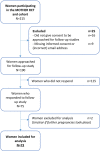Recurrence, postponing pregnancy, and termination rates after hyperemesis gravidarum: Follow up of the MOTHER study
- PMID: 34033123
- PMCID: PMC8457209
- DOI: 10.1111/aogs.14197
Recurrence, postponing pregnancy, and termination rates after hyperemesis gravidarum: Follow up of the MOTHER study
Abstract
Introduction: Hyperemesis gravidarum (HG) complicates 1% of pregnancies and has a major impact on maternal quality of life and well-being. We know very little about HG's long-term impact after an affected pregnancy, including recurrence rates in future pregnancies, which is essential information for women considering subsequent pregnancies. In this study, we aimed to prospectively measure the recurrence rate of HG and the number of postponed and terminated subsequent pregnancies due to HG. We also aimed to evaluate if there were predictive factors that could identify women at increased risk for HG recurrence, and postponing and terminating subsequent pregnancies.
Material and methods: We conducted a prospective cohort study. A total of 215 women admitted for HG to public hospitals in the Netherlands were enrolled in the original MOTHER randomized controlled trial and associated observational cohort. Seventy-three women were included in this follow-up study. Data were collected through an online questionnaire. Recurrent HG was defined as vomiting symptoms accompanied by any of the following: multiple medication use, weight loss, admission, tube feeding or if nausea and vomiting symptoms were severe enough to affect life and/or work. Outcome measures were recurrence, postponing, and termination rates due to HG. Univariable logistic regression analysis was used to identify predictive factors associated with HG recurrence, and postponing and terminating subsequent pregnancies.
Results: Thirty-five women (48%) became pregnant again of whom 40% had postponed their pregnancy due to HG. HG recurred in 89% of pregnancies. One woman terminated and eight women (23%) considered terminating their pregnancy because of recurrent HG. Twenty-four out of 38 women did not get pregnant again because of HG in the past. Univariable logistic regression analysis identifying possible predictive factors found that having a western background was associated with having weight loss due to recurrent HG in subsequent pregnancies (odds ratio 12.9, 95% CI 1.3-130.5, p = 0.03).
Conclusions: High rates of HG recurrence and a high number of postponed pregnancies due to HG were observed. Women can be informed of a high chance of recurrence to enable informed family planning.
Keywords: hyperemesis gravidarum; induced abortion; pregnancy outcome; recurrence; reproductive behavior; risk assessment; risk factors; secondary prevention.
© 2021 The Authors. Acta Obstetricia et Gynecologica Scandinavica published by John Wiley & Sons Ltd on behalf of Nordic Federation of Societies of Obstetrics and Gynecology (NFOG).
Conflict of interest statement
BWM reports grants from the National Health and Medical Research Council (NHMRC) outside the submitted work. The rest of the authors have nothing to disclose.
Figures
References
-
- Einarson TR, Piwko C, Koren G. Quantifying the global rates of nausea and vomiting of pregnancy: a meta analysis. J Popul Ther Clin Pharmacol. 2013;20:e171‐e183. - PubMed
-
- Fiaschi L, Nelson‐Piercy C, Gibson J, Szatkowski L, Tata LJ. Adverse maternal and birth outcomes in women admitted to hospital for hyperemesis gravidarum: a population‐based cohort study. Paediatr Perinat Epidemiol. 2018;32:40‐51. - PubMed
-
- Poursharif B, Korst L, MacGibbon K, Fejzo M, Romero R, Goodwin T. Elective pregnancy termination in a large cohort of women with hyperemesis gravidarum. Contraception. 2007;76:451‐455. - PubMed
-
- Fiaschi L, Nelson‐Piercy C, Tata LJ. Hospital admission for hyperemesis gravidarum: a nationwide study of occurrence, reoccurrence and risk factors among 8.2 million pregnancies. Hum Reprod. 2016;31:1675‐1684. - PubMed
MeSH terms
Grants and funding
LinkOut - more resources
Full Text Sources
Other Literature Sources
Miscellaneous


